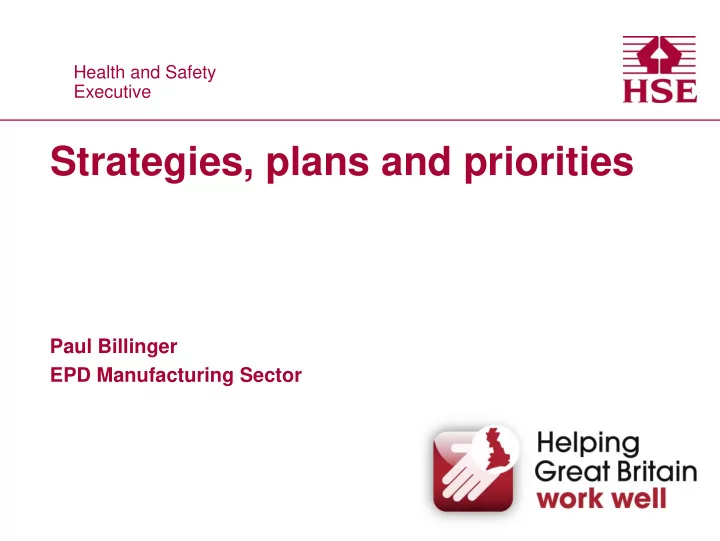

Health and Safety Health and Safety Executive Executive Strategies, plans and priorities Paul Billinger EPD Manufacturing Sector
Cover • Health and Work Strategy • Sector Plans • Operational priorities
Who I am, what I do Lead for manufacturing sector: • stakeholder engagement • operational priorities and planning • policy and national strategies • determining standards and benchmarks • advice and guidance • research
Why health and safety? What is the point of health and safety? Saving lives Saving lives Preventing suffering Preventing suffering
Helping Great Britain Work Well
HSE Health and Work Strategy
HSE Health and Work Strategy Published December 2016 Priority areas: • occupational lung disease • musculoskeletal disorders • occupational stress and mental health Does not mean that other issues will be ignored
Our aim To work in partnership with employers, employees and the wider health and safety community to reduce the incidence rate and number of new cases for these priority areas.
Priority areas Occupational lung disease • continues to lead to an estimated 12 000 deaths each year. Musculoskeletal disorders • most common reported cause of occupational ill health in GB, accounting for 41% of all work-related ill-health cases and 34% of all working days lost due to ill health.
Priority areas Work-related stress • second most commonly reported cause of occupational ill health in GB, accounting for 37% of all work-related ill-health cases, and 45% of all working days lost due to ill health.
Our approach: • working with others, using our expertise for the wider good of workers, businesses (especially SMEs) and government; • championing the need for prevention; • focusing our inspection and enforcement activity where it can have the most effect.
What HSE will do: • actively contributing, where competent, to cross- government initiatives; • engage and support the wider community; • use evidence-based and innovative approaches to drive behavioral change; • maintaining and enhancing the enforcement profile and to hold those responsible to account ; • review health research programme; • demonstrate business costs of not tackling health issues
Lung disease: how bad is it? “The legacy of historic exposures can often mask the need for action today. Can we be truly confident that our current approach isn’t leading another generation to early death, suffering and harm?” Professor David Fishwick Chief Medical Adviser to HSE
Lung disease: controlling exposure Recognise that deaths now are likely due to past exposures • can’t change the past but can ensure that current risks are controlled • don’t want our new inspectors in 20 years standing up and saying the same things that I am today
Lung disease: why act? Terry the stone mason Phil the welder silicosis after exposure to asthma after exposure to silica dust welding fume
Sector Plans
Draft Sector Plans for: Agriculture Manufacturing Bioeconomy Mines Chemicals Offshore energy Commercial consumer services Onshore oil and gas Construction Public services Explosives Quarries Fairgrounds and theme parks Sports and leisure Film broadcasting, theatre and events Utilities Gas and pipelines Waste and recycling Logistics and transport
Sector Plans: cover For each sector we have: • a draft plan covering its health and safety performance • identified the top three strategic priorities for the next three to five years • actions we propose to take
Sector Plans: approach For each sector we propose to: • lead and engage with others to improve workplace health and safety • provide an effective regulatory framework • secure effective management and control of risk • reduce the likelihood of low-frequency, high- impact catastrophic incidents
Sector Plans: manufacturing
Priorities: manufacturing • controlling exposures to substances causing occupational lung disease • reducing the incidence of common work-related ill-health conditions, such as MSDs and work- related stress • preventing serious incidents involving heavy loads, during maintenance activities and catastrophic events
Priorities: public services • reducing the high levels of ill health from work- related stress and MSDs • tackling specific safety issues in high-hazard activities, such as realistic training in the military • maintaining established standards as service provision becomes fragmented and new forms of delivery emerge
Priorities: logistics and transport • reducing the impact of poorly controlled loads • reducing the rate of ill health caused by musculoskeletal disorders • increasing engagement with work-related road risk
What next? To help make further improvements, we will be starting a discussion early in the New Year with the wider health and safety community before publishing later in 2017 • please visit the website • send us any comments.
FOD operational priorities
FOD inspections targeting: • manufacturing (specific parts) • fresh produce • agriculture (specific areas) • end of life vehicle sites • small scale construction • waste and recycling at LAs • fairgrounds • Legionella
Inspection in manufacturing • target sectors with known health problems • proactive inspections must cover: – occupational health topic – other matters of evident concern • specific guidance to inspectors about what and how to cover the topic – includes initial enforcement expectations for a number of scenarios
Manufacturing priorities (2015-18) • respirable crystalline silica – stone working, brick, ceramics/potteries, concrete products, foundries • foundry fume and other substances • wood dust • flour dust and other organic dusts – food, grain milling • welding fume – fabricated metals – ship and boat building
…Priorities (2015-18) • metalworking fluids – fabricated metals • plastic fume • rubber fume • various substances – surface engineering • MSD in food
…some safety issues • heavy loads • fire and explosion: solvents and dusts • developing technologies: – additive manufacture (3D printing) – collaborative robots (cobots) • influencing supply chain (acting responsibly)
Next workyear (provisional) Build on current initiatives: • manufacturing: health & catastrophic events • fairgrounds • agriculture • Legionella • radiation • construction (plus some other specific initiatives under consideration)
Preventing suffering Preventing suffering Saving lives Saving lives Reminder
Questions?
Recommend
More recommend